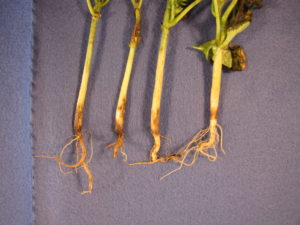The wilted and dead leaves of the watermelon transplants in Figure 1 could have several causes. Above ground symptoms such as wilts and leaf death may be caused by problems underground. When I investigated the plants in Figure 1, I found that many of the plants had a root rot. The dark area at the base of the stem (technically, the hypocotyl) is caused by a fungus that is growing in the plant (Figure 2). The fungus also can be found on the roots of the plant.

Figure 2. The dark area at the base of the stem is a result of infection by the fungus Thielaviopsis basicola, causal agent of black root rot of watermelon.
This disease is known as black root rot of watermelon. The fungus that causes this disease is Thielaviopsis basicola. This fungus causes a similar disease on carrot, tobacco, pansies and many more crops. The dark area on the base of the stem is actually a ‘sign’ of the disease since the fungus that causes the disease is visible. The wilting and decline of the plant is a ‘symptom’ of the disease since it is a result of the infection.
This disease can best be controlled by good sanitation. In this situation, the soil-like mix, the plastic transplant trays and/or a piece of equipment became contaminated with the fungus. When the watermelon were seeded in the trays, the fungus began to attack the plants. To avoid black root rot, start with clean soil-like mix and clean or well sanitized equipment and trays.
